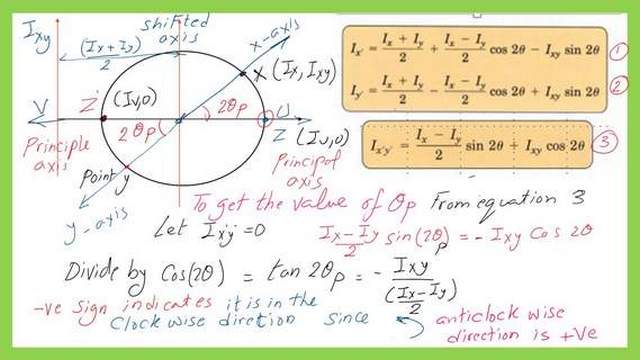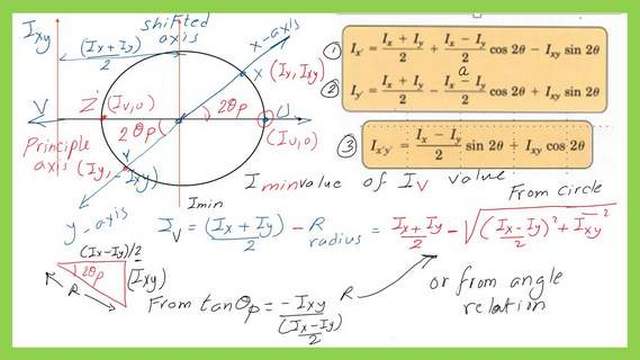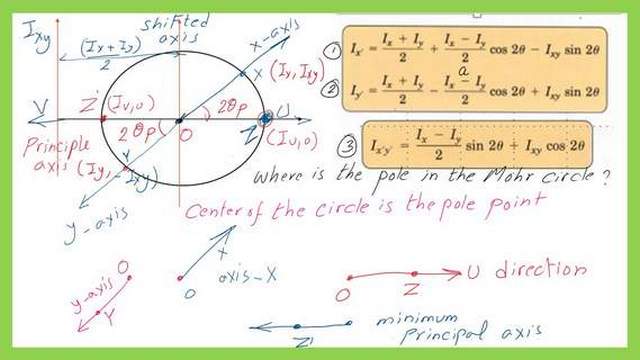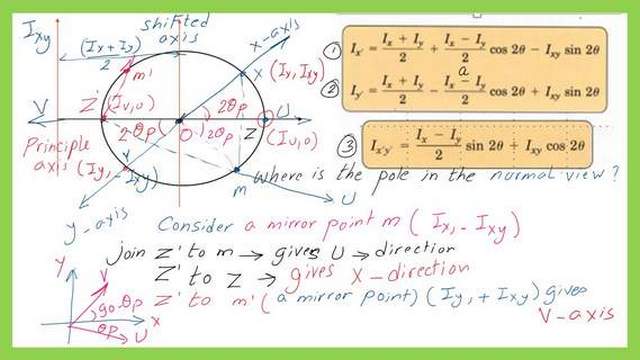Last Updated on September 13, 2025 by Maged kamel
Mohr’s Circle of Inertia part-2.
Point of minimum value of inertia.
We will continue our discussion about Mohr’s circle of inertia in part 2. The previous part 1 illustrated how to draw Mohr’s circle of inertia and find the values of Imax, Imin, and Ixy. The next question is how we could find the principal axes directions?
The point of the minimum value of inertia is point Z’, where the Ixy value equals zero. What about the direction of the V axis?
The direction is obtained from Mohr’s circle of inertia by an enclosed angle of (180-2θp) in the anti-clockwise direction or (2θp )from the Y-axis in the clockwise direction.
While in the Normal view, it has an angle of (90-θp) from the x-axis in the anti-clockwise direction.
The expression of tan 2θp.
In Mohr’s Circle of Inertia part-2, the value 2θp can be estimated from the third equation by setting Ix’y’ to zero. This will give the 2θp value equal to (-Ixy/(Ix-Iy/2)). The negative sign will indicate that the angle is in the clockwise direction.

The expression of Imax using Mohr’s circle.
The value of Imax or Iu can be estimated as equal to the distance between Ixy and the center of the circle, which equals (Ix+Iy)/2 plus the radius value. Checking the tan 2θp expression, we can draw an angle and get the radius value for Ixy, Ix, and Iy.
Please refer to the next slide image for deriving the value of the radius R.

The expression of Imin using Mohr’s circle.
From the next slide in Mohr’s Circle of Inertia part-2, the value of Imin or Iv can be estimated as equal to the shift, which is (Ix+Iy)/2 minus the radius value.
Checking the tan 2θp expression, we can draw an angle, get the radius value of Ixy, Ix, and Iy, and deduct the value of (Ix+Iy)/2.

The expression of pole point.
The pole point in Mohr’s circle of inertia is the point from which you can get direction, and the circle’s center is the pole point. When we join point X, it will give the X-axis.
While joining with point y, you can get the Y direction. Similarly, a line from the circle’s center to point Z will give the principal maximum or U direction.

The pole point in Mohr’s circle for the normal view.
From the last slide, we can get the pole of the standard view as point Z’ joining the mirror point of x, which will give the U direction in the normal view, and joining the mirror of point y will give the V direction.
The U direction makes θp from the x-axis measured clockwise. For the V direction, it makes an angle of (90-θp) from the same axis but in an anti-clockwise direction. This maintains a 90-degree angle between the U and V axes.

Thanks a lot, and peace be upon you all.
A video covers the topic of the previous post and this Post.
The following post is Easy Approach to Mohr’s Circle of inertia-First Case.
This link to a useful external resource: a calculator for Cross-Section, Mass, Axial and polar area moment of Inertia, and Section Modulus.
